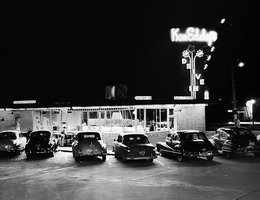
During World War II, the rationing of gasoline meant that families on the home front could not travel the way they might have wanted to. After the war, the end of rationing and higher salaries put Nebraskans on the road in record numbers. America’s love affair with the automobile was renewed, as family cars and hot rods became indispensable parts of 50s life and culture. The car culture spawned businesses, like drive-in restaurants and movie theatres.

With more people on the roads, there was a great need for more and better roads. Today, we take good roads for granted. But, even by the 1950s almost all roads in the U.S. were two lanes with cars entering from uncontrolled cross roads. The idea of "superhighway" system — with multiple, one-way lanes divided from each other and with controlled access on and off the highway — had been around since the 1930s. But it was not until a military man, former Gen. Dwight D. Eisenhower, became president that the plan moved into reality. As a young officer, Eisenhower had been part of the Army’s first motor convoy to travel across the continent, from Washington, D.C., to San Francisco. The trip took two months — the cars got stuck in mud or sand, trucks crashed through wooden bridges, and they had trouble with slippery and dusty roads. So, when he became president, he pushed through the "National System of Interstate and Defense Highways" bill. The theory was that good roads would help move troops and equipment in case the U.S. was attacked during the Cold War.
In 1956, Congress passed the new law. Construction of Interstate 80 began in Nebraska in the late 1950s with money provided by the federal government. Most of the work was done in the 1960s. Nebraska later became the first state to complete its toll-free interstate system in the early 1970s.